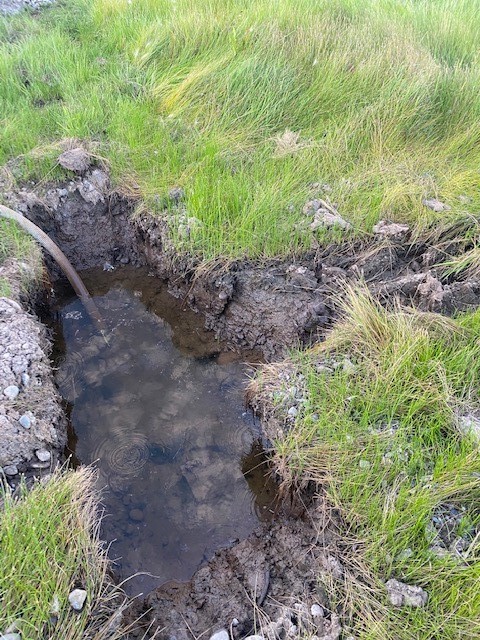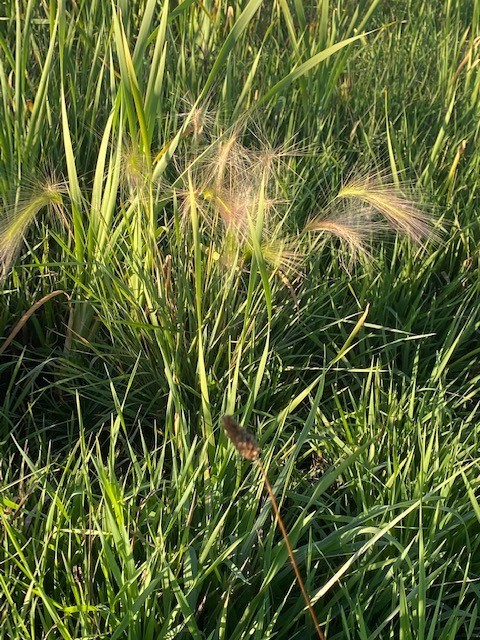What We Don’t Know
We need to learn to listen to those little voices in our heads. We don’t need to act on all of them because many of them are not in our best interest, but we do need to at least acknowledge them and consider their meanings. We can categorize these thoughts and inclinations as “slow down and smell the roses.”
Take the time to look at your tasking and evaluate what hiccups might occur. The future is uncertain but having a little foresight into how things will pan out can help maximize your time and efforts in the present. One of my learning experience this year regarding this thinking comes in the form of drainage and water flow.
Last year, I was so disappointed that my grasses (and weeds) stalled short of being able to cut. This year, I was focused on seeding and fertilizing. I had mild success in irrigation practices. I only had the ability to flood irrigate by tarping and with short stubby vegetation, I took for granted the potential of controlling the water to the best of my ability. Regardless, I still only had tarps and my shovel to irrigate and so when the water turned on, I thought I was ready to get things going.
Perspective
There is a video clip I remember of a monkey that lifts a big rock and underneath it is a snake. The monkey gets scared when he sees the snake. He faints and falls. The rock goes back down, and the monkey wakes up. When he wakes, the monkey lifts the rock back up again, sees the snake, and faints again. He even does it a third time.
Sometimes I feel like I am that monkey. I made a mental note to myself last year to double check the ditches to find any potential problem areas. Custom Farms had told me it’s always a good idea to have the fields V-ditched too. It was on my “to do” list. The snow came. Then spring came. Seed and fertilizer were applied to the fields once we were able to. I walked the fields and thought to myself that it looked good enough.
Also, in terms of water drainage, I thought gravity would send the wastewater to the closest drain. My focus was the grass. First cut was great. There was no rain in April and very little in May. This was the year of the six-week winds that seemed to just dry up the ground and grass stubble. Still, irrigation seemed to work well.
A person usually has great visibility in the first cut because grass is barely existent and controlling water is not too hard once your ditches are established. I put in some decent shovel time, but overall, things worked well. I had my first cut about the middle of June. I feel like I cut well before many other people did. The reason I chose to cut at this time was because the grass had already been seeded out for three weeks and growth had drastically slowed down. Most of my neighbors seemed to have their first cut right around July 1.
When we cut hay, we cut the fields. I always forget that the ditches will continue into second cut with high grass and the warmer weather of summer invites all the diversity of weeds.
Bring on the Rain
Second cut was a totally different beast. I couldn’t see the ditches at all, let alone the water in them. I used a handheld brush cutter to clear away the setting points where I would drop my canvases. I could set the canvas but would have to walk out to into the cut field and post up over time to see if water was still flowing the same. It was not.
The grass was dense along the ditch. There was also willow and cattails that were crowding in. It was frustrating to trudge through this just to set tarps. Frustration also extended into watching water leak around the dams, overflow in spots that were not visible, and dissipate drastically over the length of the ditch without reason.
To be honest, sometimes I just felt like going through the motions of just placing the settings was good enough for the day. I noticed that there were more bare spots in the field that did not receive water. There were also places where water was accumulating very heavily. I was liking how the first cut went and for as much optimism as I had with first cut, the same amplitude of frustration was building with the second cut. I began to dread going out in the morning and evening to irrigate.
Listen to the Land
Talking with one of the guys over at the Southern Ute Agriculture department, we were discussing the diversity of forage in the field during summer, how persistent evasive trees can be, and water flow. We talked about how the weeds are telling us what is going on with the land and even what needs to be done about it.
Sunflowers and thistle thrive in dry areas and so occasionally, you may see them pop up right in the middle of your field where grass is not present. They will show you where you have dry spots over time.
In contrast, willow, cattail, and chicory will emerge from vastly wet areas. This tells us that we have been over irrigating a piece of land and that it needs to be dried out for a spell. You will also see your grass begin to turn a dark brown (especially near the roots).
After the second cut, you either must own your own equipment to adjust the water flow, wait on a very long list for help from the Tribe, or simply do what you can and make that all elusive “mental note” to make sure you take care of that before next year. This is that monkey looking under the rock predicament coming back around.
My advice: V-ditch as much as you can in the spring to keep water flowing. Locate all the areas that are holding still water right now and mark those for ditching. Look at where willow and cattail are growing. These are areas that need to be drained. Corrugate your field to give it some consistency in water coverage and thus maximize your water efficiency.








